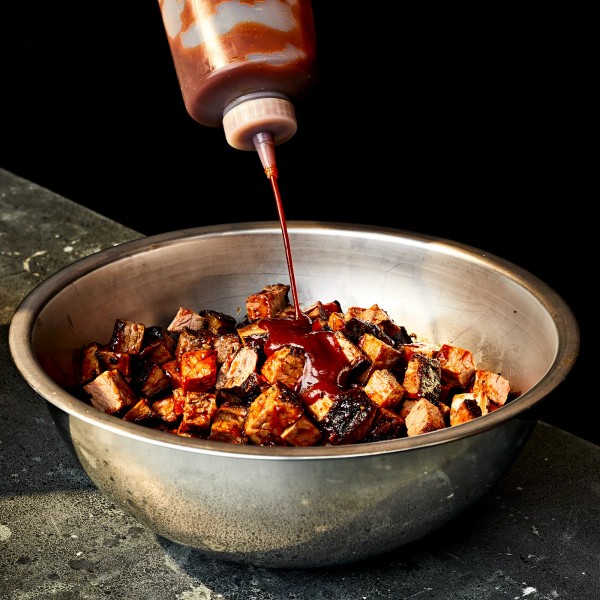Make 2021 F&W Best New Chef Matt Horn’s burnt ends the star of your next barbecue.
If you've ever been handed the crusty bits of smoked brisket from the cutting board of a benevolent pitmaster, then you've tried burnt ends, a style of barbecue that originated in Kansas City in the 1900s. In the realm of American barbecue, burnt ends have the most texture of any regional style, a higher ratio of salty crust to smoky meat that amplifies its flavor and gives it a deeply satisfying chew.
Pitmaster Matt Horn calls these little flavor bombs "meat candy." The self-taught cook and 2021 F&W Best New Chef draws a line of hungry customers every day at his Oakland joint, Horn Barbecue. Horn isn't wedded to any barbecue genre – he's an equal opportunity pleaser – and his burnt ends reflect his restless culinary innovation. After smoking brisket for hours and forming the bark, he cubes the meat to create more surface area. Then he tosses the cubes with a bourbon-laced sauce and puts them back in the smoker for a couple of hours to further concentrate their flavor. As the collagen melts, the sugary crust begins to caramelize.
"You're looking for that candied texture on the burnt ends," Horn says. "I eat them with white bread and maybe a pickle and am good to go."
But to ignore the panoply of scratch-made sides at Horn's eponymous restaurant would shortchange your barbecue experience. Some of them, like Nina's Potato Salad (named for Horn's wife) and Classic Slaw, are as transcendent as his burnt ends or his legendarily juicy, wobbly brisket. The sides strike a balance; they're neither too rich nor too light. Together with the burnt ends, they make a balanced, delicious menu for a summer holiday barbecue, perfectly suited for the coal-fired cook-out holidays of Juneteenth, Father's Day, and Independence Day that punctuate the summer.
Horn taught himself how to barbecue during his restless 20s in the backyard of his grandmother's house in Fresno, California, before taking his craft to farmers' markets and eventually opening a brick-and-mortar location in Oakland. He's recently added the Southern chicken concept Kowbird to his portfolio as well as a new cookbook, called Horn Barbecue: Recipes and Techniques from a Master of the Art of BBQ. The book conveys his passion and distills his hard-won lessons. "It's for the every-weekend-barbecue-enthusiast [sitting] in the backyard with a beer," Horn says. "Before I started selling my product at a farmers' market, that backyard was my spiritual place. I was one with nature and one with fire."
1. Season Brisket
Burnt Ends
Photo by Victor Protasio / Food Styling by Torie Cox & John Somerall / Prop Styling by Audrey Davis
Sprinkle brisket point evenly with salt and Horn rub, gently massaging seasonings into the meat. Let brisket stand, and preheat smoker.
2. Smoke Brisket
Burnt Ends
Photo by Victor Protasio / Food Styling by Torie Cox & John Somerall / Prop Styling by Audrey Davis
Smoke brisket over charcoal and oak chunks at 250°F until a meat thermometer inserted in center registers 150°F.
3. Wrap and Cook to Target Temp
Burnt Ends
Photo by Victor Protasio / Food Styling by Torie Cox & John Somerall / Prop Styling by Audrey Davis
Remove brisket from smoker, and wrap tightly in aluminum foil. Continue smoking until a meat thermometer registers 185°F, about 2 hours.
4. Chop and Trim
Burnt Ends
Photo by Victor Protasio / Food Styling by Torie Cox & John Somerall / Prop Styling by Audrey Davis
Remove brisket from smoker, and unwrap. Cut meat into 3/4-inch cubes, discarding any large pieces of fat.
5. Toss with Sauce
Burnt Ends
Photo by Victor Protasio / Food Styling by Torie Cox & John Somerall / Prop Styling by Audrey Davis
Stir together brisket cubes and bourbon sauce until well coated. Transfer to a 13- x 9-inch aluminum baking pan, and drizzle evenly with honey.
6. Smoke and Caramelize
Burnt Ends
Photo by Victor Protasio / Food Styling by Torie Cox & John Somerall / Prop Styling by Audrey Davis
Add hot coals to smoker to increase temperature to 275°F. Smoke cubed brisket in baking pan until caramelized and glazed, 2 to 3 hours.
This article was from Food & Wine and was legally licensed through the Industry Dive Content Marketplace. Please direct all licensing questions to legal@industrydive.com.













